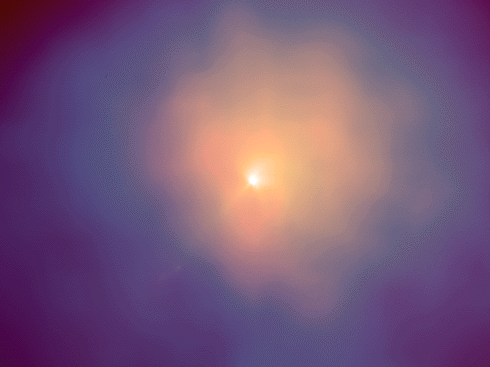Explanation: The atmosphere of a comet comes and goes. Approaching the sun, it swells as material from the icy cometary nucleus is warmed and evaporated by increasing sunlight. Immense but tenuous and fleeting, the inner atmosphere or inner "coma" of comet Hyakutake is seen in this false color picture. Oriented with the sunward direction toward the upper right, the picture is a composite of Hubble Space Telescope images recorded on April 3 and 4, 1996. It is about 14,000 km across (comparable to Earth's diameter) and is a combination of images showing dust reflected light (red) and ultraviolet light scattered from Hydrogen atoms (blue). Hyakutake's Hydrogen atoms were produced by the breakup of water (H20) molecules evaporating from its nucleus. The Hydrogen data, combined with other observations, indicate that this comet's nucleus, itself only a few km across, was producing about 7 to 8 tons of water per second.
1999 2000 2001 2002 2003 2004 2005 2006 2007 2008 2009 2010 2011 2012 2013 2014 2015 2016 2017 2018 2019 2020 2021 2022 2023 2024 2025 |
Yanvar' Fevral' Mart Aprel' Mai Iyun' Iyul' Avgust Sentyabr' Oktyabr' Noyabr' Dekabr' |
NASA Web Site Statements, Warnings, and Disclaimers
NASA Official: Jay Norris. Specific rights apply.
A service of: LHEA at NASA / GSFC
& Michigan Tech. U.
|
Publikacii s klyuchevymi slovami:
atmosphere - comet Hyakutake - kometa Hiyakutake - koma - yadro komety - led
Publikacii so slovami: atmosphere - comet Hyakutake - kometa Hiyakutake - koma - yadro komety - led | |
Sm. takzhe:
Vse publikacii na tu zhe temu >> | |
